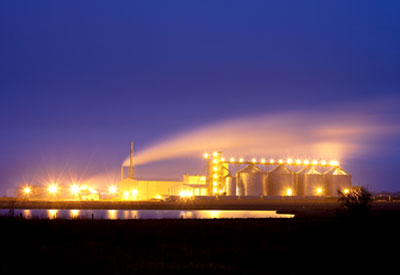Energy Use in the Ethanol Industry
Fuel ethanol production is a complex, energy intensive process that has experienced periods of significant growth throughout the United States. Benchmarks were developed in an ethanol manufacturing study conducted by MnTAP to provide a comparison for facilities. The report includes materials benchmarks (ethanol yield in gallons per bushel of corn used), energy benchmarks (energy use per gallons of ethanol produced), and water benchmarks (water use in gallons of water used per gallon of ethanol produced). Typical best practices include efficiencies related to water use, renewable energy sources, or waste heat recovery processes.
An ethanol facility uses a large amount of thermal energy (90% of the total energy consumed) in the form of steam for starch conversion, distillation, and evaporation; or natural gas for destroying VOCs and drying the distiller grains. Thermal energy is primarily produced from fossil fuels such as natural gas (and sometimes coal) with propane or diesel providing backup. Given that fossil fuels such as natural gas, oil, and coal are not renewable, there are additional benefits when fossil fuel use is minimized.
Electrical energy represents 10% of the total energy consumed in an ethanol facility. Electricity is used to power pumps, fans, hammermills, agitators, and centrifuges. As with many energy intensive industries, there are continuing opportunities to reduce the amount of energy consumed through equipment innovations, process operating efficiencies, and recovery of waste energy. Reductions in energy consumption will likely be driven by energy costs.
Energy Best Practices
Best practices include those that leverage opportunities within the local market, such as selling wet distillers grains with solubles (WDGS) instead of dried distillers grains with solubles (DDGS). Many best practices provide multiple benefits. Some best practices that were once considered innovative are now considered standard practice in facilities. For example, the mole sieve used in the dehydration process was introduced in the 1990s and significantly reduced energy use. It is now standard equipment in all dry mill facilities. Provided are a few best practices for energy use in ethanol facilities. To view the complete list, see the MnTAP report, Ethanol Benchmarking and Best Practices [PDF 445KB].
- Heat Recovery:The heat recovery steam generator (HRSG) is the default application for heat recovery when a thermal oxidizer (TO) is installed. Other opportunities include installing boiler economizers, preheating dryer air, or preheating process water.
- Ring Dryers (vs. Rotary Dryers):It is estimated that a ring dryer consumes 5-10% less energy than a rotary dryer due to reduced air leakage.
- Combined Heat and Power (CHP):When a CHP process is used to produce energy the overall efficiencies can improve from 49% for a conventional facility to 75% for a CHP facility. CHP processes use a combination of natural gas or steam turbines, HRSG, boilers, gasifiers, or thermal oxidizers to convert waste heat or steam into electrical power.
- Use of Variable Frequency Drives (VFD) and High Efficiency Motors:Using VFDs for operations that require varying motor speeds or when the equipment is oversized will reduce electrical consumption. There are also opportunities to install higher efficiency motors when existing motors fail and have to be replaced.
